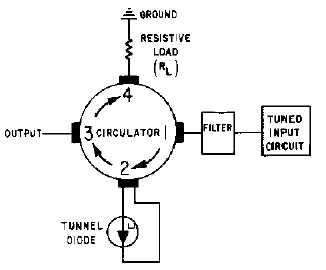2-44
Figure 2-41.—Tunnel-diode amplifier.
The desired frequency input signal is fed to port 1 of the circulator through a bandpass filter. The
filter serves a dual purpose as a bandwidth selector and an impedance-matching device that improves the
gain of the amplifiers. The input energy enters port 2 of the circulator and is amplified by the tunnel
diode. The amplified energy is fed from port 2 to port 3 and on to the mixer. If any energy is reflected
from port 3, it is passed to port 4, where it is absorbed by the matched load resistance.
TUNNEL-DIODE FREQUENCY CONVERTERS AND MIXERS.—Tunnel diodes make
excellent mixers and frequency converters because their current-voltage characteristics are highly
nonlinear. While other types of frequency converters usually have a conversion power loss, tunnel-diode
converters can actually have a conversion power gain. A single tunnel diode can also be designed to act as
both the nonlinear element in a converter and as the negative-resistance element in a local oscillator at the
same time.
Practical tunnel-diode frequency converters usually have either a unity conversion gain or a small
conversion loss. Conversion gains as high as 20 dB are possible if the tunnel diode is biased near or into
the negative-resistance region. Although high gain is useful in some applications, it presents problems in
stability. For example, the greatly increased sensitivity to variations in input impedance can cause high-
gain converters to be unstable unless they are protected by isolation circuitry.
As with tunnel-diode amplifiers, low-noise generation is one of the more attractive characteristics of
tunnel-diode frequency converters. Low-noise generation is a primary concern in the design of today's
extremely sensitive communications and radar receivers. This is one reason tunnel-diode circuits are
finding increasingly wide application in these fields.
Q-48. Name the procedure used to reduce excessive arcing in a magnetron?
Q-49. What causes the negative-resistance property of tunnel diodes?
Q-50. What determines the frequency of a tunnel-diode oscillator?
Q-51. Why is the tunnel diode loosely coupled to the cavity in a tunnel-diode oscillator?
Q-52. What is the purpose of the circulator in a tunnel-diode amplifier?

